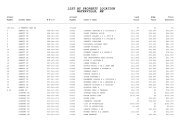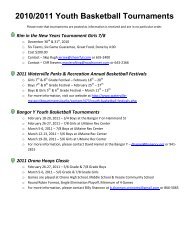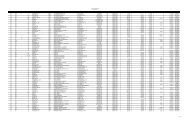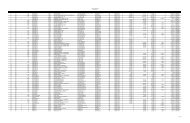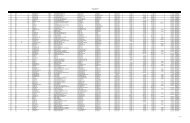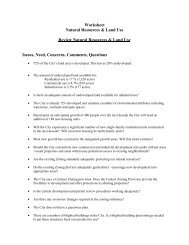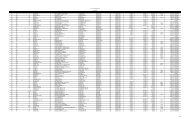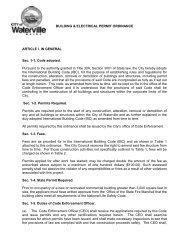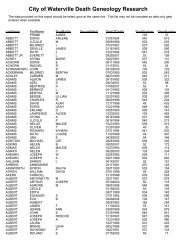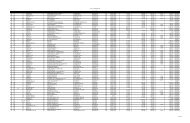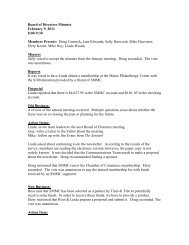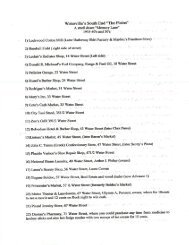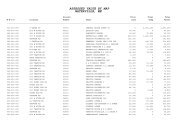Airport Master Plan 2012 - City of Waterville
Airport Master Plan 2012 - City of Waterville
Airport Master Plan 2012 - City of Waterville
You also want an ePaper? Increase the reach of your titles
YUMPU automatically turns print PDFs into web optimized ePapers that Google loves.
individual aircraft currently use or are forecast to use the airport at a level <strong>of</strong> 500 operations per year.<br />
However, these heavier aircraft represent a group <strong>of</strong> corporate aircraft that should be considered in future<br />
pavement design for Runway 5-23 and associated taxiways. Anecdotal evidence suggests that limited<br />
operations <strong>of</strong> heavier aircraft can operate without damage or a significant reduction in the pavement’s<br />
service life. Nevertheless, the city should continue to monitor the frequency <strong>of</strong> heavier aircraft and<br />
consider pavement strengthening in future projects.<br />
Beyond strength requirements, the presence <strong>of</strong> frost susceptible soils at WVL also needs consideration in<br />
future pavement designs. Differential frost heaving <strong>of</strong> Runway 5-23, which is evident just north <strong>of</strong> the<br />
runway-runway intersection, will need to be addressed and corrected.<br />
The inspection <strong>of</strong> Runway 14-32 conducted under the facilities inventory revealed that the asphalt<br />
pavement has extensively deteriorated over time to the extent that the runway has become virtually<br />
dysfunctional. The presence <strong>of</strong> rutting along with the high frequency alligator cracking also indicates that<br />
the structural base <strong>of</strong> the pavement may be inadequate. The thickness <strong>of</strong> the pavement section and/or the<br />
quality <strong>of</strong> the materials used may be insufficient to accommodate the loadings imposed on the runway. A<br />
more comprehensive pavement evaluation would be completed as part <strong>of</strong> a future design effort prior to<br />
reconstruction <strong>of</strong> Runway 14-32.<br />
As previously discussed, the future ARC for Runway 14-32 is expected to be limited to B-I due to<br />
constraints on the runway length. Most aircraft in the B-I category typically weigh less than 12,500<br />
pounds, therefore requiring no change in the current pavement strength rating. However the potential<br />
weight <strong>of</strong> loaded snow plow trucks on this runway will likely govern the pavement strength design for a<br />
future Runway 14-32 upgrade.<br />
With regard to taxiway pavements, the newest taxiway to be reconstructed is designated “D” and was<br />
completed in 2007. The pavements <strong>of</strong> Taxiways “A”, “B”, “C”, “G”, and “H” remain in generally fair to<br />
good condition at the present time but have aged to the extent that they require regular maintenance and<br />
periodic repairs to keep them safe and functional. Future reconstruction <strong>of</strong> these taxiways should be<br />
designed with strength capacities <strong>of</strong> the respective design aircraft, with consideration to the existing frost<br />
susceptible subgrade conditions on the airfield as well as the weight <strong>of</strong> snow removal equipment expected<br />
to maintain these pavement surfaces.<br />
The terminal area pavement was reconstructed in 2007 and is in excellent condition. However the area<br />
within 60 feet <strong>of</strong> the front <strong>of</strong> the terminal aircraft hangar was not reconstructed and exhibits extensive<br />
cracking. Therefore reconstruction <strong>of</strong> this pavement is recommended during the planning period.<br />
Pavement Markings<br />
Pavement markings need to be repainted on Runway 5-23 to increase conspicuity and conformity with<br />
current FAA advisory circular 150/5340-1J standards. Runway holding position markings, with the<br />
exception <strong>of</strong> those on TW “D”, need to be repainted with 12-inch wide lines in conformance with current<br />
standards.<br />
The markings on Runway 14-32 are very faded while markings on the north ramp are almost nonexistent.<br />
Other markings on the parallel taxiway system were functional at the time <strong>of</strong> the inspection.<br />
Markings on Taxiway “D” in the terminal area were installed new in 2007. Adding precision or nonprecision<br />
approach capability to either runway will require improving the current markings accordingly.<br />
The <strong>City</strong> <strong>of</strong> <strong>Waterville</strong> Maine<br />
Facility Requirements – Page 3-6<br />
<strong>Airport</strong> Solutions Group, LLC & The Louis Berger Group, Inc. December 2011



